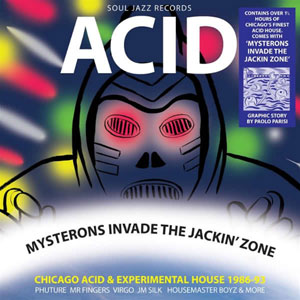Various Artists Acid: Mysterons Invade the Jackin’ Zone—Chicago Acid & Experimental House 1986-93
It’s been almost 30 years since the advent of acid house in Chicago. In the […]

It’s been almost 30 years since the advent of acid house in Chicago. In the time since then, the unmistakable sound of the TB-303 bass synthesizer has enjoyed successive waves of reinvention and popularity, becoming one of dance music’s defining characteristics in the process. Along the way, the 303 itself has become fetishized to an insane degree, fetching high prices on the secondhand market and more recently even inspiring boutique-made exact copies in the DIY underground. It’s from within this acid-crazed context that Soul Jazz finds itself as it releases Acid: Mysterons Invade the Jackin’ Zone—Chicago Acid & Experimental House 1986-93, the follow up to last year’s Invasion of the Mysteron Killer Sound digital dancehall compilation, and a spiritual companion to its 2005 acid comp, Can You Jack? Chicago Acid And Experimental House 1985-95.
But does the world need another acid-house compilation? Truth be told, Soul Jazz’s prior effort in this regard was suitably comprehensive for those new to the form, featuring many of the touchstone works now widely considered classics—that compilation was seemingly designed with the intention of being an easy point of entry. By contrast, the label’s latest offering doesn’t seem to know where it stands, offering a collection that dips pretty far into obscurity while also serving up some fairly obvious choices, albeit ones that are loud and remastered. Presumably, the thing tying it all together is a graphic novel by Paolo Parisi, which, the record’s press release states, tells the story of Chicago house via science fiction. Sadly, that graphic novel wasn’t included with XLR8R‘s review copy, so it’s hard to say how well its narrative ties the whole thing together. That being said, the compilation stands rather well, purely on the basis of its musical merits.
The two obvious cuts on here are Mr. Fingers’ “Can You Feel It?” and Housemaster Boyz’s “House Nation”—neither were on Soul Jazz’s previous acid compilation, both are essential, and both have been comped many times before. Their inclusion is made up for by a number of tracks that were overlooked previously, only available on vinyl, and, as of this writing, not uploaded to YouTube, which is saying something. The compilation starts boldly on this footing with Acid Wash’s “Hallucinate,” a cut from ’93 that stylistically looks back to the first wave of Chicago while jumping through a series of trance-inducing loops. This leads naturally into the so-goofy-it’s-good monologue of “The Jackin’ Zone” and its relentless live percussion.
From there, things start to wander between the profound and mundane. The first real peak comes in the form of the reverberating drums of Phuture’s “Slam.” Manic in its intensity, it worms its way across the stereo image with an abrasive insistence that places it at a cross section between the tougher side of Chicago and the militancy of UR-style hardcore techno. There’s other music with muscle as well, as Larry Heard drops the prefix from his alias and appears as “Fingers” to deliver “Ecstacy” and “Juice,” two of his most brutal rhythm tracks since his Gherkin Jerks project. Derrick Carter follows closely, in his The Unknown guise, with a Detroit-indebted cut called “Abstract Expressionism” that differentiates itself via vinyl spinbacks and other assorted tape-deck manipulations.
Given the often campy nature of the first wave of acid house, it’s not entirely surprising that the compilation can sometimes get a little too cheesy to take. The spoken word on Pleasure Zone’s “I Can’t Understand,” while seemingly totally earnest, is also ridiculously melodramatic; A Blackman A Blackman and Another Blackman’s “I Believe” mixes a Newcleus “Jam on It” bassline with “Baby Wants to Ride” vocals with questionable results; and even though JM Silk’s “Music Is the Key (Underground Mix)” is a classic, there really are far better tracks by that producer that could have made the cut. Then again, there are so many acid tracks that it must be a nightmare to decide which ones to include; in the case of this compilation, the proceedings could have used a more considered approach.

